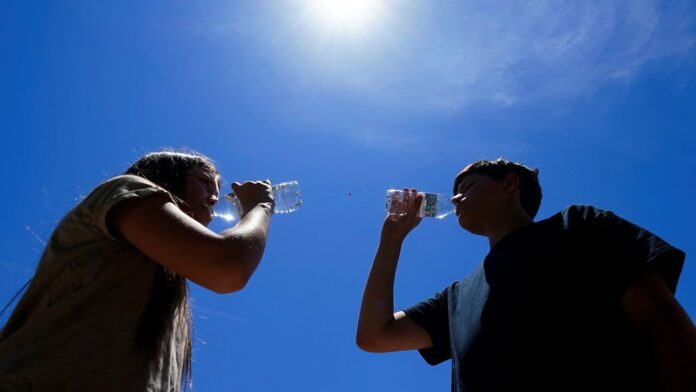The Biden administration on Wednesday launched a federal dashboard to track heat-related illnesses, a new tool that officials say will target health resources and provide life-saving interventions for communities most impacted by extreme temperatures.
The first-of-its-kind tool comes as the country has been impacted by a wave of scorching temperatures from coast-to-coast. Scientists recently confirmed that July was the world’s hottest month on record.
The new dashboard is a collaboration between the Department of Health and Human Services’ Office of Climate Change and Health Equity and the National Highway Traffic Safety Administration.
“Heat is no longer a silent killer,” said HHS Secretary Xavier Becerra in a statement announcing the new tool. “From coast-to-coast, communities are battling to keep people cool, safe and alive due to the growing impacts of the climate crisis.
“President Biden is committed to providing communities with the resources they need to stay safe,” Becerra continued. “The EMS HeatTracker is a powerful tool from the Biden-Harris Administration that brings actionable information to prioritize outreach and interventions, helping prevent heat-related illnesses and death and build resilience across the nation.”
The tracker will help state, local and regional government officials determine where to prioritize heat mitigation strategies and help officials set up interventions like cooling centers and outreach to at-risk populations during heat emergencies.
The tool will show state and county-level heat-related emergency medical services activations, as well as display patient breakdowns by race, gender, age and other factors to show the severity with which populations experience health risks from heat.
“Heat is the most lethal of all types of extreme weather and heat exposure is worsening with increasing global warming,” said Dr. John Balbus, acting director of OCCHE. “But existing data on heat-related deaths don’t shed light on where people actually fall ill. This new dashboard makes it possible to see where the needs are greatest, plan for the future, and save lives.”
The Biden administration last month announced new actions aimed at improving protections for workers in heat, improving weather forecasts and expanding access to drinking water.
He also announced a directive for the Department of Labor to issue hazard alerts notifying employers and employees about ways to stay protected from extreme heat, which has killed 436 workers since 2011, according to federal statistics, and ordered the agency to increase inspections of potentially dangerous workplaces such as farms and construction sites and strengthen enforcement of heat safety violations.
The Labor Department is also developing a standard for how workplaces deal with heat. The proposed rule by the Occupational Safety and Health Administration would require employers to provide adequate water and rest breaks to outdoor workers, as well as medical services and training to address signs and symptoms of heat-related illness. OSHA is holding meetings this summer to hear comments on how the heat standard would affect small businesses.
To keep low-income populations cool, the Department of Health and Human Services expanded its Low Income Home Energy Assistance Program to provide more access to air conditioning and cooling centers such as libraries, senior centers or other public buildings. The Environmental Protection Agency also has provided assistance to help communities develop cooling centers within schools.
The National Oceanic and Atmospheric Administration has been helping cities and towns map “heat islands” with dense buildings and fewer trees, and the Department of Agriculture issued guidance for creating more tree canopy coverage, which helps with cooling environments.
In addition, the administration launched a website called heat.gov with interactive maps, weather forecasts and tips for keeping cool amid record-breaking heat.
Spectrum News’ Maddie Gannon and The Associated Press contributed to thsi report.



